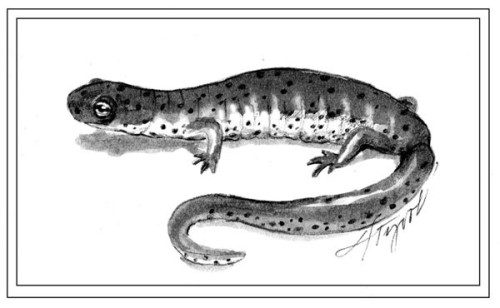
Let’s start out with a riddle: What animal has 16 toes and a tail that breaks off when grabbed by a predator? Not sure? Here’s another clue: It’s the smallest terrestrial vertebrate in our area. If you didn’t guess four-toed salamander, don’t feel bad—it’s probably also the least-known salamander in the North Country.
The four-toed salamander (Hemidactylium scutatum) holds a number of dubious distinctions. Besides its diminutive size (a typical adult may only reach 2-3 inches in length), it is also the only terrestrial salamander with four toes on all four feet. With the exception of the aquatic mudpuppy (which happens to be our largest salamander), all other salamanders have five toes on their hind feet. Four-toeds also have specialized breeding habitat requirements, which probably accounts for their limited distributions in both Vermont and New Hampshire. Combine that with their small size and cryptic behavior, and you have a recipe for an animal that very few people have ever heard of, let alone encountered.
Superficially, the four-toed salamander resembles two of our most abundant and widespread salamanders—the eastern red-backed and northern two-lined salamanders. However, thanks to three distinct characteristics, four-toed salamanders are relatively easy to identify. First, there’s the four toes on the back feet thing. Second, their bellies are bright white, speckled with black. And third, they have a unique constriction at the base of the tail, as if a tight rubber band was left there for too long. This is what herpetologist Jim Andrews calls the “pinch-me-here mark,” and it’s where the tail will detach from the salamander’s body if attacked by a predator. This ingenious adaptation is enhanced by the fact that the tail twitches for several minutes after it detaches, distracting any would-be predator from the salamander, which often holds perfectly still. In addition, unlike other salamanders whose tails must be pulled to break off, four-toeds can drop their tails at-will. Then, over the course of the next couple weeks the tail grows back, ready for the next encounter.
The nesting behavior of the female four-toed salamander is quite unusual. Like their larger and better-known relative, the spotted salamander, four-toeds spend the majority of their time in upland forests and migrate to fishless wetlands to deposit eggs in the spring. However, that’s where any similarities end. While both male and female spotted salamanders migrate in order to mate and lay eggs in the water, only female four-toeds migrate—having mated the previous fall—and they lay their eggs in specialized nests on land adjacent to wetland pools. The female then guards the eggs for several weeks. Upon hatching, the larvae drop into the water where they develop until metamorphosis.
Although breeding sites include a variety of wetlands, the most common feature of four-toed nesting habitat is the presence of sphagnum moss. Typically, females construct crude cavities within moss mats where they deposit 20-50 eggs, although they will occasionally use rotten logs, grassy hummocks, or leaf litter. Often, many females will share moss clumps, depositing up to 800 eggs in a single communal nest, which is then guarded by just one or two females.
A recent study by a group of scientists from James Madison University and California State University, found that females tending communal nests were more likely to have antifungal skin bacteria that inhibited the growth of a deadly embryo fungus. The presence of these skin bacteria correlated with higher embryonic survival and lower rates of catastrophic nest failure for communal nests compared to solitary nests.
In addition to specialized breeding habitat, elevation also appears to be a limiting factor for this species. Al Richmond, a University of Massachusetts biologist who conducted surveys for four-toed salamanders in Maine, found that all occupied breeding sites were below 1,000 feet in elevation. If that limitation holds true for other states in northern New England, it would severely limit the distribution of this species, especially since lower elevations are more likely to be developed. In Vermont, where the four-toed salamander is listed as a Species of Special Concern, its stronghold is the Champlain Valley; there are just two disjunct records from the Connecticut River Valley. In New Hampshire, where it is considered vulnerable, most of the scattered records are from the southern third of the state.
Although an encounter with our smallest terrestrial vertebrate may not generate as much excitement as seeing a moose (our region’s largest vertebrate), it should hold greater significance given the rarity of the four-toed salamander. And due to its specialized habitat requirements and cryptic behavior, some four-toed populations undoubtedly remain undiscovered, and are therefore under-protected. Keep a lookout for this diminutive salamander and report any sightings to the Vermont Reptile and Amphibian Atlas Project or the Vermont Atlas of Life.


Discussion *